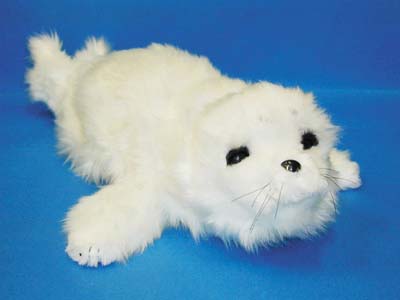Seal of Approval
Back to Contents of Issue: June 2002
|
|
|
|
by Tim Hornyak |
|
 FOR HARRIED VICTIMS OF the 21st-century rat race who have tried oxygen therapy, aromatherapy and other newfangled stress cures without success, a promising remedy is in the offing: robot therapy. Scientists at Japan's National Institute of Advanced Industrial Science and Technology are planning to commercialize a robot seal they say is a proven relaxant. Paro looks like a stuffed baby harp seal with its snow-white fur, dark eyes and whiskers, but underneath the antibacterial pelt is an array of sophisticated sensors and actuators. Paro can respond to visual, auditory and tactile stimuli from users and react by wriggling with delight when petted and showing displeasure when ignored. It even has a circadian sleep-wake cycle. Creator Takanori Shibata, a senior research scientist at the institute, took the critter to the children's ward of the University of Tsukuba Hospital to test its effects on 16 patients in an experiment that ended in March 2001. Staff reported that Paro helped relieve kids' anxiety and restlessness and improved communication with caregivers. Ryosuke Arai, an autistic 12-year-old boy, even recovered his appetite and speaking ability while interacting with Paro at the hospital. "The robot is just like a real animal and makes me feel relaxed," the boy was quoted as saying in a report by NHK TV. In another test, the pup was taken to a daycare center for 22 elderly people for a 5-week study. Shibata's team tested the urine of people who played with Paro and found that their stress levels had dropped in measurements of two hormones; their social interaction skills also improved.  Research has shown that pets can lower blood pressure and diminish tension in humans simply by being present. Studies have found that pet owners visit the doctor less often and even have a better chance of surviving following hospitalization. But rules at care centers and some older people's inability to care for animals can deprive them of the benefit.
Research has shown that pets can lower blood pressure and diminish tension in humans simply by being present. Studies have found that pet owners visit the doctor less often and even have a better chance of surviving following hospitalization. But rules at care centers and some older people's inability to care for animals can deprive them of the benefit."In Japan, most hospitals and nursing homes do not allow people to bring animals in," says Shibata. "In my experiment, Paro encouraged people at the hospital and nursing home and increased communication among patients...In addition, Paro reduced burnout among caregivers." Shibata, who did research at the Massachusetts Institute of Technology's Artificial Intelligence Laboratory under its director Rodney Brooks, says that through physical contact, users can develop an attachment to machines like Paro. There are currently three Paros -- they are the sixth generation since Shibata started building pet robots in 1995 with a prototype that had two motion actuators, four sensors and a relatively primitive 6811 CPU. Seeking to build intelligent personal robots for everyday use, he chose a seal because users presented with machine versions of more familiar animals such as dogs or cats will compare them to the real thing and are more likely to notice flaws. He showed Paro off at the recent Robodex 2002 exhibition in Yokohama as well as the Science Museum in London earlier this year, where it attracted the attention of a researcher from Guinness World Records. After reviewing the results of Shibata's studies, the book publisher certified Paro as the 'World's Most Therapeutic Robot.' Shibata plans to enhance Paro and wants to commercialize the next generation, both for institutional and retail sales. Although production numbers have yet to be determined, he estimates the downy 'droid would come with a price tag of a few hundred thousand yen. That's about the same cost as a relaxing package tour from Japan to Greenland, a harp seal habitat. @ |
|
Note: The function "email this page" is currently not supported for this page.





